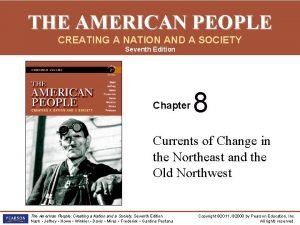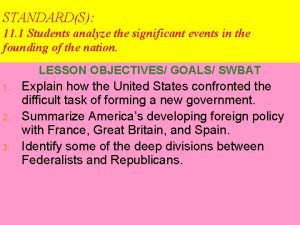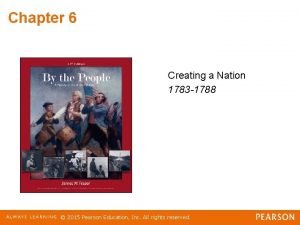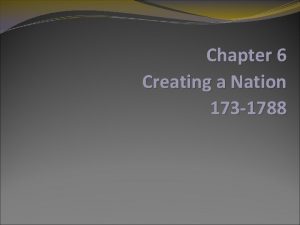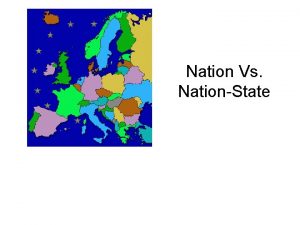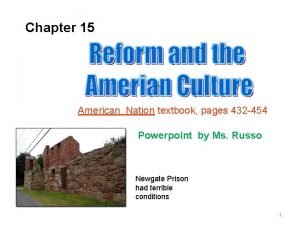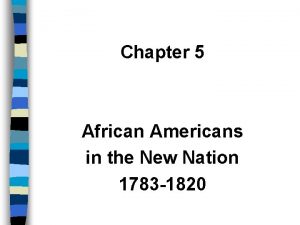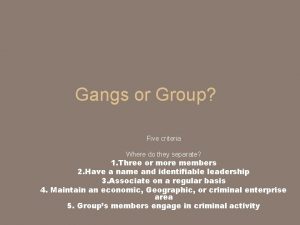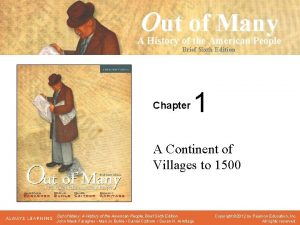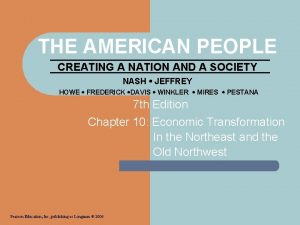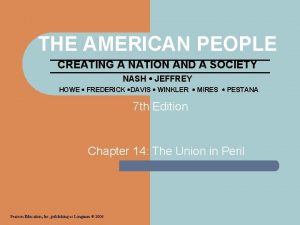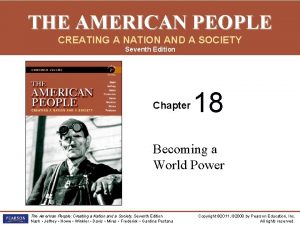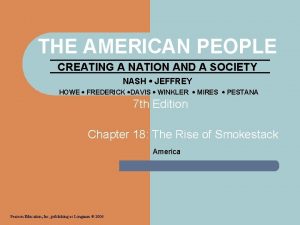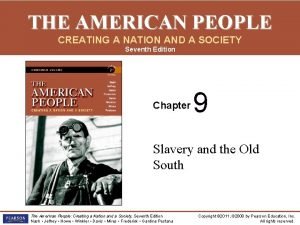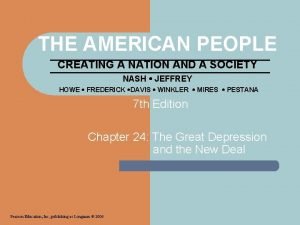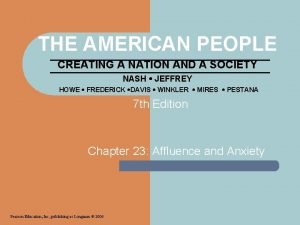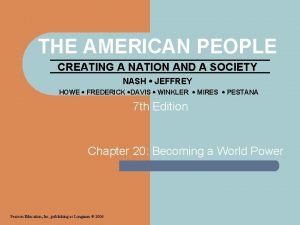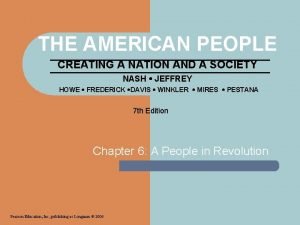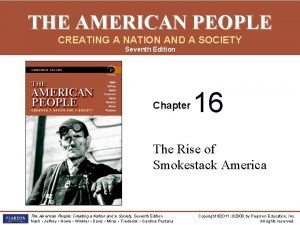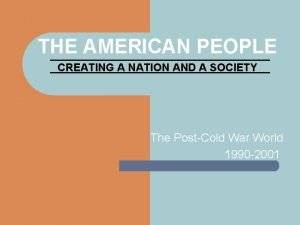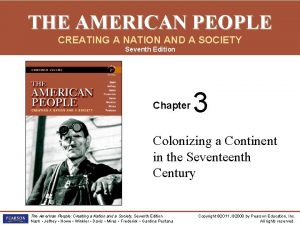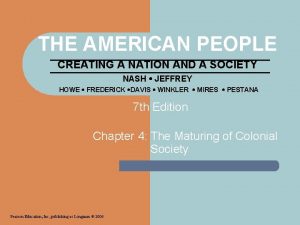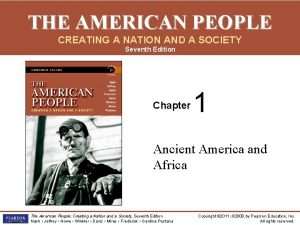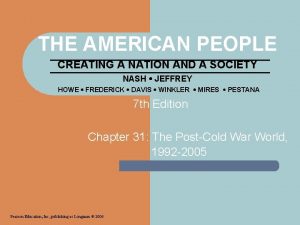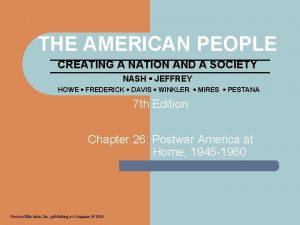THE AMERICAN PEOPLE CREATING A NATION AND A






























































- Slides: 62

THE AMERICAN PEOPLE CREATING A NATION AND A SOCIETY NASH JEFFREY HOWE FREDERICK DAVIS WINKLER MIRES PESTANA 7 th Edition Chapter 1: Ancient America & Africa Pearson Education, Inc, publishing as Longman © 2006

PEOPLES OF AMERICA BEFORE COLUMBUS l l l Who were the first inhabitants of the Americas? Where did they come from? What were they like? How had the societies they formed changed over the millennia that preceded the European arrival? Can their history be reconstructed?

MIGRATION TO THE AMERICAS l l l Archaeologists have unearthed remains pointing to the arrival of humans in America at about 35, 000 BCE [about the same time humans began to settle Japan and Scandinavia] Native American peoples believe they emerged from under the earth or from a large lake or out of the sky to occupy their land in North America Scientists, however, generally agree that the first inhabitants of the Americas were nomadic travelers from Siberia

MIGRATION TO THE AMERICAS l These peoples traversed an ancient land bridge which connected northeast Asia with Alaska – – – l Approximately 600 miles wide and existing between 25, 000 and 14, 000 years ago as the result of glacial absorption of large areas of water Ice free passages through Canada were limited to beginning and end of the period Scientists think main migration occurred 11, 000 to 14, 000 years ago Some evidence suggests multiple migrations from several regions of Asia and even from Europe


HUNTERS, FARMERS & ENVIRONMENTAL FACTORS The migrants moved south (over 15, 000 miles) to the tip of South America and east over 6000 miles to the eastern coast of North America Phases of Native American history: l Initial period of migration (ended about 14, 000 years ago) l PALEO-INDIAN ERA (14, 000 to 10, 000 years ago): l – – Big-game hunters flaked hard stones into spear points and chose “kill sites” A more reliable food source allowed population growth and increased settle habitation and limited migration

HUNTERS, FARMERS & ENVIRONMENTAL FACTORS l ARCHAIC PERIOD (10, 000 to 2, 500 years ago): – – – Glaciers retreated and a warming trend turned grasslands into desert Pleistocene mammals declined but humans adjusted and learned to exploit new sources of food, especially plants Agricultural Revolution: 9, 000 -7, 000 years ago humans learn how to plant, cultivate and harvest

HUNTERS, FARMERS & ENVIRONMENTAL FACTORS Environmental Devastation: l The first wave of humans found an abundance of megafauna: gigantic animals Changes in environment and over-hunting wiped most of the huge animals out by about 10, 000 years ago l Extinction of huge beasts left behind a small selection of large beasts and led to increased hunting of smaller animals and may have reduced their populations l Erosion, deforestation, and salinization added to America’s environmental stresses over the centuries

HUNTERS, FARMERS & ENVIRONMENTAL FACTORS l Archeologists estimate agriculture began in the Americas about 5, 000 BCE – – – l l Agriculture had already been developed in southwestern Asia and in Africa It moved to Europe about the same time agriculture began in central Mexico As agriculture increased it led to settled village life, fueled population growth, encouraged greater social and political complexity Regional trading networks formed For centuries after the end of the Archaic period around 500 BCE, native societies grew in size, developed more sophisticated agriculture, and, in some areas, adapted to a sedentary life


MESOAMERICAN EMPIRES l l l Mesoamerica: the middle region bridging the great land masses of North and South America The Aztec people of present-day Mexico numbered 10 to 20 million people in 1492 and controlled most of central Mexico The Aztec capital of Tenochtitlán (“Place of the Prickly Pear Cactus”) later became Mexico City and boasted a population of some 150, 000 people making it comparable to Venice and also one of the world’s greatest cities

MESOAMERICAN EMPIRES l Aztec society was divided into four classes: – – Nobility (including the Emperor’s household, priests and military officers) Free commoners with rights to land organized in precincts with temples and schools Serfs, who were bound to the soil and worked for nobles Slaves, who had rights akin to slaves in ancient Greece or Rome


REGIONAL NORTH AMERICAN CULTURES l l In the southwestern region of North America, Hohokam and Anasazi societies (ancestors of the present-day Hopi and Zuñi) developed established communities thousands of years before Europeans arrived in the 1540 s By 1200 CE, these Pueblo people, as the Spanish called them, were developing planned villages – – – The largest was at Pueblo Bonito in Chaco Canyon and had 800 rooms Pueblo people used irrigation canals, dams and hillside terracing to water maize fields In some ways, Pueblo society resembled peasant communities in many parts of Europe and Asia

REGIONAL NORTH AMERICAN CULTURES l Native peoples of the Pacific Northwest (Tlingit, Kwakiutl, Salish, and Haida) formed villages of several hundred drawing their sustenance from fish and living in plank houses with cedar pillars and giant totem poles – Carved masks often portrayed the four interconnected zones of the cosmos: the Sky World, the Undersea World, the Mortal World, and the Spirit World

REGIONAL NORTH AMERICAN CULTURES l Ceremonial masks played a pivotal place in the Potlatch, a great winter gathering with song, dance, and ritual – – Leaders honored their family lineage and signified their chiefly authority in the tribe By giving away many of their possessions, chiefs satisfied tribe members and maintained their legitimacy

REGIONAL NORTH AMERICAN CULTURES l In the east, Native American societies were traced back as far as 9000 BCE and came to be loosely associated in four main language groups: Algonquian, Iroquoian, Muskhogean, and Siouan – Gradually adopted semifixed settlements and developed trading networks that linked societies

REGIONAL NORTH AMERICAN CULTURES l Mound Builders of the Ohio and Mississippi Valleys – – l Ancestors of Creek, Choctaw, and Natchez Participated in a vast trading network across the continent Declined many centuries before Europeans reached the continent, perhaps attacked by other tribes or damaged by severe climate changes Another society arose around 600 CE with its center at Cahokia (20, 000, maybe 40, 000 inhabitants) and the first metropolis in North America Numerous small tribes settled from Nova Scotia to Florida influenced by the mound-building cultures


REGIONAL NORTH AMERICAN CULTURES l l l In the far north were the Abenaki, Penobscot, and Passamaquoddy who lived by the sea and supplemented their diet with maple sugar and a few foodstuffs Further south in what became New England were Massachusetts, Wampanoag, Pequot, Narragansett, Niantic, Mahican, and others In mid-Atlantic area were the Lenape, Susquehannock, Nanticoke, Pamunkey, Shawnee, Tuscaroras, Catawba and other peoples who often lived in watershed villages

REGIONAL NORTH AMERICAN CULTURES l In the Southeast were densely populated rich and complex cultures tracing their ancestry back 8, 000 years – – – Belonged to several language groups, some joined in loose confederacies Created elaborate pottery and basket weaving and conducted long distance trade Also influenced by mound-building burial techniques Global warming trend helped agriculture flourish in this area and led to highly-stratified societies Ancestors of Creek, Yamasee, Apalachee, Choctaw, Chickasaw, Natchez, and Cherokee as well as several dozen smaller tribes After “Little Ice Age” after 1300 they abandoned their mounded urban centers and devolved into less populous, less stratified, and less centralized societies


THE IROQUOIS l Five tribes composing League of the Iroquois: Mohawk, Oneida, Onondaga, Cayuga, and Seneca – – – Began as a vast extension of kinship group and embraced 10, 000 people at time of European contact Created a more cohesive political confederacy that gained stability, increased population, and had internal mechanisms for solving internal problems and presenting a more unified front Facilitated the development of a coordinated Iroquois policy for dealing with the Europeans

THE IROQUOIS l l l Pallisaded villages of about 1000 people performed work communally and owned land in common Matrilineal and matrilocal families whose women could divorce their husbands just by setting her husband’s possessions outside the longhouse door Political authority derived from the senior women of the ohwachiras—a group of related families – – Named the men representing the clans at village and tribal councils and appointed the 49 sachems or chiefs who served as the council of the Five Nations Caucused behind the circle of chiefs and made sure the tribal council did not move too far from the will of the women who appointed them

THE IROQUOIS: Men & Women l l Men did most of the hunting and fishing while women were the agriculturalists While men went on weeks-long hunting expeditions, women stayed in the village Women supplied the moccasins and food for warring expeditions and a decision to withhold these supplies was a veto of military activity Clan matrons could initiate war by demanding captives to replace fallen clan members

THE IROQUOIS: Children l Iroquois parents were more permissive than Europeans – – – Did not believe in harsh physical punishment Encouraged the young to imitate adult behavior Were tolerant of early fumbling attempts Mother nursed and protected the infant (often not weaning until three or four) but hardened it with baths of cold water Childhood interest in the anatomy and in sexual experimentation was accepted as normal

THE IROQUOIS: Authority l Approach to authority lacked most of complicated European machinery to direct ordinary lives – l There were no laws and ordinances, sheriffs and constables, judges and juries, or courts or jails Yet Iroquois set boundaries of acceptable behavior firmly, prizing the autonomous individual yet maintained a strict code of right and wrong – – Governed behavior by imparting a sense of tradition and attachment to the group through communally performed rituals Culprits tended to be “shamed” and ostracized until the culprits atoned for their actions and proved ready for re-entry into village communal life

PRE-CONTACT POPULATION l Recent archeological research indicates that Native American agriculture was capable of sustaining a large population – – l New estimates of the pre-contact population of America north of the Rio Grande place it at about 4 million At least half lived east of the Mississippi River and some 700, 000 along the eastern coast and in the piedmont region Some estimates put the population of the Western Hemisphere at about 50 to 70 million – – – 70 to 90 million in Europe (including Russia) 50 to 70 million in Africa 225 to 350 million in Asia



PRE-CONTACT POPULATION l l Horses and oxen did not exist in the Americas Without large draft animals there was no incentive to invent wheeled vehicles or even the potter’s wheel Did not have the technology of smelting iron On the other hand, corn and potatoes, valuable crops to Indians, did not exist in Europe

CONTRASTING WORLDVIEWS l l l The stark differences in European and American cultures stemmed from perceptions of social relationships and interaction with the environment Europeans saw the earth as filled with resources for humans to use and exploit for their own benefit and separated the secular and sacred parts of life Native Americans did not separate the sacred and the secular and saw every aspect of the natural world as sacred to whom one owed reciprocal relations

CONTRASTING WORLDVIEWS Property: Europeans l Believed that land was a resource to be exploited for human gain and believed in property lines, inheritance of land, and courts to settle resulting land disputes l Basis of sustenance and independence, wealth, status, political rights, and identity l Social structure mirrored patterns of land ownership

CONTRASTING WORLDVIEWS Property: Native Americans l Believed that land had sacred qualities and should be held in common l Communal ownership limited social stratification and increased a sense of sharing in most Native American communities

CONTRASTING WORLDVIEWS l l While the majority of Europeans were peasant farmers living in relatively isolated kin-centered villages, in the cities there emerged a wealthconscious, ambitious individual who valued and sought wider choices and greater opportunities to enhance personal status Native American traditions stressed the group and valor over the individual and wealth – EXCEPTIONS: Aztecs and Incas had highly developed, populous, and stratified societies

CONTRASTING WORLDVIEWS l l Many Native American societies were matrilineal which contrasted with patrilineal European societies where women held strongly subordinate positions While Native American women were subordinate, they also supplied three-fourths of the nutritional needs and directed village life when men were away

CONTRASTING WORLDVIEWS TRADE l Native Americans: way of preserving interdependence and equilibrium between individuals and communities – Ceremonies of reciprocity: gift giving and pipe smoking Europeans: economic exchange RELIGION l Europeans: single divinity, written scriptures, trained and highly literate clergy and churches with structured ceremonies l Native Americans: no literary tradition, polytheistic, based in nature, sought to conciliate spirits that surrounded them in natural world l

AFRICA ON THE EVE OF CONTACT l l Portuguese captain Antam Gonçalves made the first European landing on the west coast of sub-Saharan Africa was a continent full of diverse and sophisticated cultures – Vision of African backwardness perpetuated by the slave trade

THE SPREAD OF ISLAM l Two themes: – – l Muhammad, the Prophet of Islam, began preaching the tenants of his revelations in 610 BCE – – l Rise of great empires in West and Central Africa (then called the Sudan) Spread of Islam By the end of the tenthcentury, Egypt predominantly Muslim Spread southward to northern Sudan Eventually, the religion encompassed most of the Eastern Hemisphere and became the main intermediary for exchanging goods, ideas, and technologies


KINGDOMS OF CENTRAL AND WEST AFRICA l l Sophisticated agriculture Iron production began among Nok in presentday Nigeria about 450 BCE Cultural and political development was largely dependent on ecological conditions Fertile rain forests of Niger River basin became home of some of Africa’s greatest empires

KINGDOMS OF CENTRAL AND WEST AFRICA: Ghana Empire l l Developed between fifth and eleventh centuries between Sahara and Gulf of Guinea and from the Atlantic Ocean to the Niger River Major empire noted for its extensive urban settlement, sculpture and metalwork, long distance commerce, and complex political and military structure Wealth built primarily on trade By eleventh century, trade not only brought wealth but Muslim influence

KINGDOMS OF CENTRAL AND WEST AFRICA: Mali Empire l l Kingdom of Ghana destroyed in the eleventh century due to religious strife resulting from the invasion of Muslim warriors Replaced by Islamic kingdom of Mali, dominated by the Malinke, or Mandingo, people – – Effective agricultural production and control of gold trade Cultivated rice and harvested inland deltas for fish Under Mansa Musa, in 1307, Mali controlled three times as much territory as kingdom of Ghana Timbuktu was the center of the empire with famous Islamic university

KINGDOMS OF CENTRAL AND WEST AFRICA: Songhai Empire l 1332: when Mansa Musa died, power shifted to Songhai, centered on the middle of the Niger River – – l l Mixture of farmers, traders, fishermen and warriors who declared independence from Mali in 1435 Peaked under Sonni Ali (1464 -1492) and Muhammad Ture (1493 -1528) Collapsed when some tribes broke away and Morocco in 1591, equipped with European guns, captured Timbuktu and Gao in effort to control gold and salt trade Likely that the fall of this last great West African empire made it easier for slave trade


KINGDOMS OF CENTRAL AND WEST AFRICA: Kongo & Benin l Kongo: further south along Atlantic coast and in Central Africa – – – l Portuguese encountered in 1482 Capital of Mbanza a trade center for several million people and for the Portuguese who were sending Catholic missionaries by the 1490 s Began trade in slaves with Portuguese Benin: formed about 1000 CE west of the Niger Delta – Europeans reached hundred of years later and made it a center of the slave trade

AFRICAN SLAVERY l l Slavery existed as a normal social condition in this period and had little to do with skin color Slaves were a sign of wealth for the owners Mostly African societies sold criminals or prisoners of war From the tenth to the fifteenth century, 5000 West Africans were sold: – – – as sugar workers in Egypt as domestic servants and craftspeople throughout the Arabic world, and as soldiers in North Africa

AFRICAN SLAVERY l Islam facilitated process by establishing secure trade routes connecting West Africa with the Mediterranean world and lands to the east – – l Was an occasional practice though on the rise Not about supplying gangs of field workers Slaves within African society often lived little differently than free people and the status of slavery was not inherited and always held the potential for reversal

THE AFRICAN ETHOS l As in Europe, the center of African social organization was the family unit – l l Unlike Europeans, families were organized in a variety of ways, many of them, like many Native Americans, matrilineal Individualism was seen as distasteful and widely disdained Africans believed in a supreme Creator of the cosmos and a pantheon of lesser deities associated with natural forces, that could intervene in human affairs and were therefore honored – West Africans, like Native Americans, believed spirits inhabited the natural world which was due respect as a result

THE AFRICAN ETHOS l Africans also worshiped ancestors, who they believed mediated between the Creator and the living – – l l Elaborate funeral rituals to ensure proper entrance to afterlife Led to deep family loyalty and regard for family lineage West Africans believed in spirit possession Like Europeans, Africans shared a belief in an invisible “other world” inhabited by the souls of the dead who could be known through revelations that spiritually gifted people could interpret – Helped create hybrid African Christianity

THE AFRICAN ETHOS Social organization: l King at top l Supported by nobles and priests (usually elderly men) l Great mass of the people, who were mostly cultivators of the soil, were beneath them – l In urban centers, craftspeople, traders, teachers, and artists lived beneath the ruling families Slaves were at the bottom of society

EUROPE ON THE EVE OF INVADING THE AMERICAS l l Ninth Century: Cahokia mounds were being built, the Kingdom of Ghana was rising, and western Europe was an economic and cultural backwater Two dynamic culture centers: – – Christian Byzantium Islam

THE REBIRTH OF EUROPE l Stemmed from revived Italian trade with longdistance ports around 1000 CE and led to a rediscovery of forgotten ancient knowledge – l Brought wealth and power to the Italian commercial cities, which gradually evolved into merchantdominated city-states that freed themselves from the rule of feudal lords Merchants led the emerging city-states

THE REBIRTH OF EUROPE l Western Europe’s feudal system gradually weakened – l l Thirteenth- and fourteenth-centuries kings reasserted their political authority and sought to unify their realms by curbing the power of the feudal lords and lesser nobles Concurrently, the peasants suffered from famine as agricultural production failed to keep up with population increase after 1300 Bubonic Plagues struck the weakened population – – Had killed nearly one-third of the population in China Then followed trade routes to India and the Middle East hitting the cities hardest Reached western Europe and North Africa in 1348 Killed 30 million Europeans over next quarter century

THE REBIRTH OF EUROPE l Black Death produced economic disruption, violent worker strikes and peasant uprisings – – l Promoted the unification of old realms into early modern states as nobilities were reduced in size Feudal lords treated their peasants better for a time because their labor, vastly reduced, was more valuable In England these developments led to a distinctive political system – – – Magna Carta in 1215 Development of English Parliament which worked with Crown during the sixteenth century to create more unified state Enclosure movement helped turn peasant farmers into wage laborers

THE REBIRTH OF EUROPE Continental Europe lagged behind England l l Far less affected by the move to “enclose” agricultural land because continental aristocrats regarded the maximization of profit as unworthy of gentlemen Continental rulers were less successful in engaging the interests of their nobilities who therefore did not share governance with their king – Would lead to absolute monarchies in sixteenth century

THE NEW MONARCHIES AND THE EXPANSIONIST IMPULSE l From 1450 onwards, France, England, and Spain sought social and political stability – – l Created armies and bureaucracies to quell internal conflict Raised sufficient taxes to support their regimes Economic distress, civil disorder, plague, and Renaissance culture encouraged impulses to expand into the New World – – To discover an eastern oceanic route to Asia To exploit the African gold trade

THE NEW MONARCHIES AND THE EXPANSIONIST IMPULSE l Portugal led the expansion of Europe – – – l 1 million inhabitants who had overcome Moorish control in the twelfth century and liberated itself from Castile in 1385 Led by Prince Henry the Navigator, supported the probing of the Atlantic by mariners Employed or copied important improvements in navigational instruments, mapmaking, and ship design Portuguese captains operated on three principles: 1. 2. 3. Earth was round Distances on its surface could be measured by degrees Navigators could “fix” their position at sea on a map by measuring the position of the stars

THE NEW MONARCHIES AND THE EXPANSIONIST IMPULSE l l 1450 s: quadrant allowed a precise measurement of star altitude necessary for determining latitude Lateen-rigged caravel, adapted from Moorish ship design, permitted ships to sail into the wind Early Portuguese discoveries—Madeira, the Canary Islands, and the Azores—were developed as first European-controlled agricultural plantations producing cash crops such as sugar By 1460, Portuguese captains had reached southern tip of Africa


DISCOVERING US HISTORY ONLINE Ancient Mesoamerican Civilizations www. angelfire. ca/humanorigins l Cahokia Mounds www. medicine. wustl. edu/~mckinney/cahokia. ht ml l Pre-Contact Cultural Areas http: //www. kstrom. net/isk/maps/houses/housingmap. ht ml http: //www. kstrom. net/isk/maps/cultmap. html l Vikings in the New World http: //www. mnsu. edu/emuseum/prehistory/vikings/vikho me. html l

DISCOVERING US HISTORY ONLINE Civilizations in Africa http: //www. wsu. edu: 8080/~dee/CIVAFRCA. HTM l The Slave Kingdoms http: //www. pbs. org/wonders/ l The Ancient West African City of Benin http: //www. nmafa. si. edu/exhibits/beninsp. htm l Life in Elizabethan England http: //www. renaissance. dm. net/compendium/home. html l Life in Sixteenth-Century France http: //www. lepg. org/index. html l Renaissance www. learner. org/exhibits/renaissance l
 The american people creating a nation and a society
The american people creating a nation and a society Creating a new nation
Creating a new nation Chapter 6 creating a nation
Chapter 6 creating a nation Chapter 6 creating a nation
Chapter 6 creating a nation Example of nation
Example of nation Country vs nation
Country vs nation Nation state vs nation
Nation state vs nation The american nation textbook answers
The american nation textbook answers Holt american nation
Holt american nation Chapter 5 african american in the new nation
Chapter 5 african american in the new nation American nation chapter 4
American nation chapter 4 American nation chapter 4
American nation chapter 4 Folk gang sign
Folk gang sign Native mob gang signs
Native mob gang signs Sureños 13 rules
Sureños 13 rules Different dimensions of people media
Different dimensions of people media In the usa the big cia
In the usa the big cia Tomer owns a daycare
Tomer owns a daycare Hình ảnh bộ gõ cơ thể búng tay
Hình ảnh bộ gõ cơ thể búng tay Slidetodoc
Slidetodoc Bổ thể
Bổ thể Tỉ lệ cơ thể trẻ em
Tỉ lệ cơ thể trẻ em Voi kéo gỗ như thế nào
Voi kéo gỗ như thế nào Chụp tư thế worms-breton
Chụp tư thế worms-breton Chúa yêu trần thế alleluia
Chúa yêu trần thế alleluia Môn thể thao bắt đầu bằng chữ đua
Môn thể thao bắt đầu bằng chữ đua Thế nào là hệ số cao nhất
Thế nào là hệ số cao nhất Các châu lục và đại dương trên thế giới
Các châu lục và đại dương trên thế giới Công của trọng lực
Công của trọng lực Trời xanh đây là của chúng ta thể thơ
Trời xanh đây là của chúng ta thể thơ Cách giải mật thư tọa độ
Cách giải mật thư tọa độ Phép trừ bù
Phép trừ bù Phản ứng thế ankan
Phản ứng thế ankan Các châu lục và đại dương trên thế giới
Các châu lục và đại dương trên thế giới Thơ thất ngôn tứ tuyệt đường luật
Thơ thất ngôn tứ tuyệt đường luật Quá trình desamine hóa có thể tạo ra
Quá trình desamine hóa có thể tạo ra Một số thể thơ truyền thống
Một số thể thơ truyền thống Cái miệng nó xinh thế chỉ nói điều hay thôi
Cái miệng nó xinh thế chỉ nói điều hay thôi Vẽ hình chiếu vuông góc của vật thể sau
Vẽ hình chiếu vuông góc của vật thể sau Biện pháp chống mỏi cơ
Biện pháp chống mỏi cơ đặc điểm cơ thể của người tối cổ
đặc điểm cơ thể của người tối cổ Thế nào là giọng cùng tên
Thế nào là giọng cùng tên Vẽ hình chiếu đứng bằng cạnh của vật thể
Vẽ hình chiếu đứng bằng cạnh của vật thể Vẽ hình chiếu vuông góc của vật thể sau
Vẽ hình chiếu vuông góc của vật thể sau Thẻ vin
Thẻ vin đại từ thay thế
đại từ thay thế điện thế nghỉ
điện thế nghỉ Tư thế ngồi viết
Tư thế ngồi viết Diễn thế sinh thái là
Diễn thế sinh thái là Dạng đột biến một nhiễm là
Dạng đột biến một nhiễm là Số.nguyên tố
Số.nguyên tố Tư thế ngồi viết
Tư thế ngồi viết Lời thề hippocrates
Lời thề hippocrates Thiếu nhi thế giới liên hoan
Thiếu nhi thế giới liên hoan ưu thế lai là gì
ưu thế lai là gì Sự nuôi và dạy con của hươu
Sự nuôi và dạy con của hươu Sự nuôi và dạy con của hổ
Sự nuôi và dạy con của hổ Hệ hô hấp
Hệ hô hấp Từ ngữ thể hiện lòng nhân hậu
Từ ngữ thể hiện lòng nhân hậu Thế nào là mạng điện lắp đặt kiểu nổi
Thế nào là mạng điện lắp đặt kiểu nổi Out of many a history of the american people
Out of many a history of the american people Latin american peoples win independence chapter 8 section 1
Latin american peoples win independence chapter 8 section 1 Transformed people transform people
Transformed people transform people
